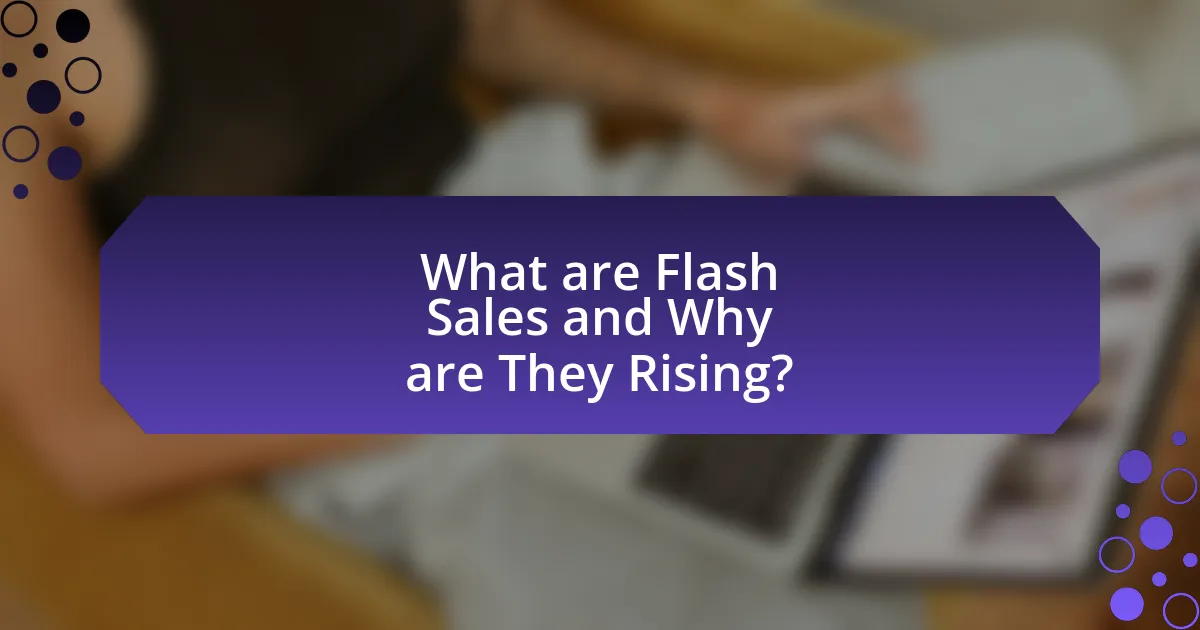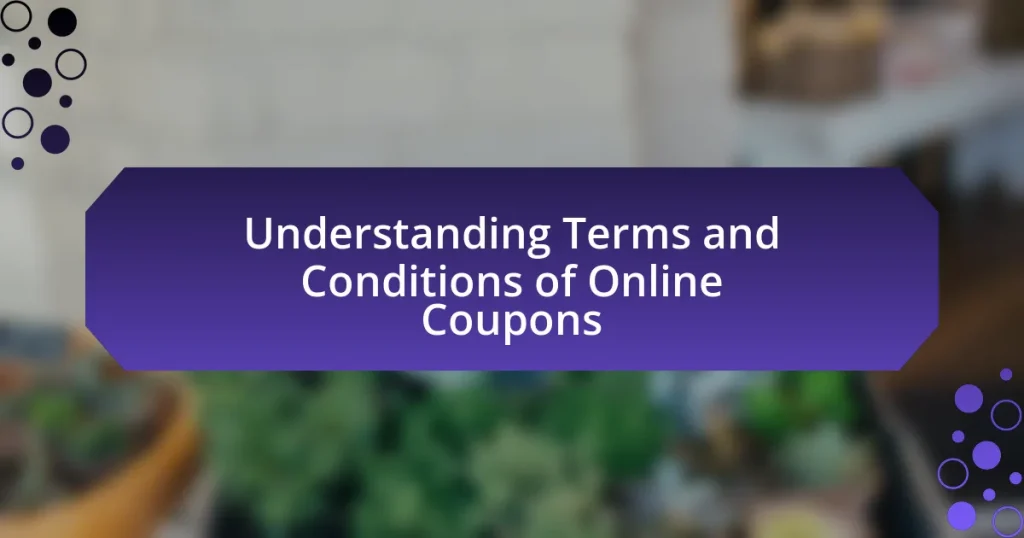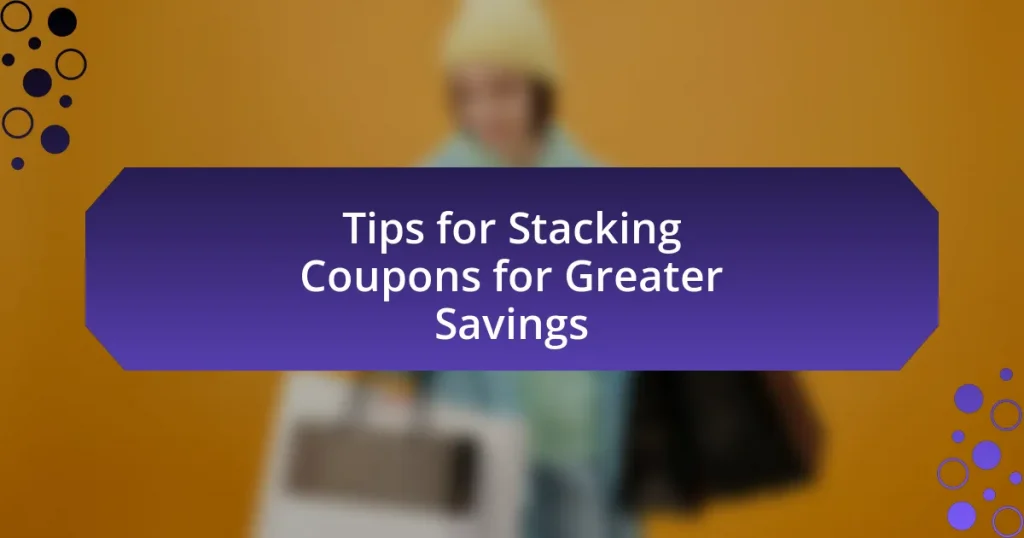Flash sales are time-sensitive promotions that offer substantial discounts on products for a limited duration, typically ranging from a few hours to a couple of days. Their popularity has surged due to the rise of e-commerce and social media, which create urgency and enhance consumer engagement. This article explores the characteristics that differentiate flash sales from traditional sales, the psychological factors driving consumer attraction, and the technological advancements facilitating their growth. Additionally, it provides insights for businesses on effectively leveraging flash sales and offers practical tips for consumers to maximize their savings during these limited-time events.

What are Flash Sales and Why are They Rising?
Flash sales are limited-time promotions that offer significant discounts on products, typically lasting a few hours to a couple of days. The rise of flash sales can be attributed to the increasing use of e-commerce platforms and social media, which create urgency and drive consumer engagement. According to a study by the National Retail Federation, 75% of consumers are more likely to make a purchase during a flash sale due to the perceived scarcity and time sensitivity, leading retailers to adopt this strategy to boost sales and clear inventory quickly.
How do Flash Sales differ from traditional sales?
Flash sales differ from traditional sales primarily in their time sensitivity and urgency. Flash sales typically offer significant discounts for a limited time, often lasting only a few hours or days, which creates a sense of urgency among consumers to make quick purchasing decisions. In contrast, traditional sales may last for weeks or months, allowing consumers more time to consider their purchases. This urgency in flash sales can lead to higher conversion rates, as evidenced by studies showing that limited-time offers can increase sales by up to 300% compared to standard promotions.
What are the key characteristics of Flash Sales?
Flash sales are characterized by limited-time offers that create urgency among consumers. These sales typically feature significant discounts on products, often lasting only a few hours or days, which encourages quick purchasing decisions. The scarcity of items available during flash sales further enhances their appeal, as consumers fear missing out on exclusive deals. Additionally, flash sales are often promoted through various marketing channels, including email and social media, to maximize reach and engagement. According to a study by the National Retail Federation, 68% of consumers are motivated to purchase during flash sales due to the perception of getting a good deal.
Why are consumers attracted to Flash Sales?
Consumers are attracted to flash sales primarily due to the urgency and perceived value they create. The limited time frame encourages quick decision-making, leading to impulse purchases. Research indicates that 70% of consumers feel a sense of urgency during flash sales, which drives them to act swiftly to avoid missing out on discounts. Additionally, the significant price reductions often associated with flash sales enhance the perceived value of the products, making them more appealing. This combination of urgency and value effectively motivates consumers to participate in flash sales.
What factors contribute to the rise of Flash Sales?
The rise of flash sales is primarily driven by consumer demand for urgency and exclusivity. This phenomenon is supported by the psychological principle of scarcity, where limited-time offers create a sense of urgency that compels consumers to act quickly. According to a study by the Journal of Marketing Research, urgency can significantly increase purchase intentions, as consumers fear missing out on a good deal. Additionally, the growth of e-commerce platforms has facilitated the rapid dissemination of flash sales, allowing retailers to reach a broader audience instantly. Data from Statista indicates that online retail sales worldwide are projected to reach $6.54 trillion by 2022, further emphasizing the increasing reliance on digital sales strategies like flash sales.
How has technology influenced the growth of Flash Sales?
Technology has significantly influenced the growth of flash sales by enabling real-time marketing and streamlined purchasing processes. The rise of mobile devices and social media platforms has allowed retailers to reach consumers instantly, creating urgency and excitement around limited-time offers. For instance, a study by the National Retail Federation found that 75% of consumers are more likely to make a purchase during a flash sale when notified via mobile alerts. Additionally, advancements in e-commerce technology, such as automated inventory management and data analytics, have allowed businesses to optimize their sales strategies and target specific customer segments effectively. This combination of immediate access and tailored marketing has driven the popularity and success of flash sales in the retail sector.
What role do social media and marketing play in Flash Sales?
Social media and marketing are crucial in driving awareness and urgency during flash sales. They facilitate real-time communication with potential customers, allowing brands to promote limited-time offers quickly and effectively. For instance, platforms like Instagram and Facebook enable businesses to reach large audiences instantly, often resulting in increased traffic and sales within a short time frame. According to a study by the National Retail Federation, 75% of consumers reported that social media influences their purchasing decisions, highlighting its significant impact on flash sales.

How Can Businesses Leverage Flash Sales Effectively?
Businesses can leverage flash sales effectively by creating urgency and exclusivity, which drives immediate consumer action. Implementing time-limited offers, such as discounts or limited stock availability, encourages customers to make quick purchasing decisions. For instance, a study by the Journal of Marketing Research found that urgency can increase sales by up to 30% during promotional periods. Additionally, utilizing targeted marketing strategies, such as email campaigns and social media promotions, can enhance visibility and reach the right audience, further boosting sales. By analyzing customer data, businesses can tailor their flash sales to specific demographics, ensuring higher engagement and conversion rates.
What strategies should businesses implement for successful Flash Sales?
Businesses should implement targeted marketing, urgency creation, and inventory management strategies for successful flash sales. Targeted marketing involves identifying and reaching the right audience through email campaigns and social media promotions, which can increase engagement and conversion rates. Creating urgency can be achieved by using countdown timers and limited stock notifications, prompting customers to act quickly. Effective inventory management ensures that businesses have sufficient stock to meet demand without overcommitting resources, which can lead to customer dissatisfaction. According to a study by the National Retail Federation, flash sales can increase sales by up to 30% when executed with these strategies.
How can businesses create urgency and excitement around Flash Sales?
Businesses can create urgency and excitement around Flash Sales by implementing time-limited offers and exclusive deals. By setting a specific timeframe, such as a 24-hour window, businesses encourage customers to act quickly to avoid missing out. Research indicates that urgency can increase conversion rates by up to 332% when customers perceive a limited availability of products (source: “The Psychology of Scarcity,” Cialdini, Robert B.). Additionally, using countdown timers on websites and promotional emails enhances the sense of urgency, prompting immediate action. Engaging social media campaigns that highlight flash sales can further amplify excitement, as sharing limited-time offers can create a buzz and attract more customers.
What are the best platforms for hosting Flash Sales?
The best platforms for hosting flash sales include Shopify, WooCommerce, BigCommerce, and Magento. Shopify is known for its user-friendly interface and extensive app marketplace, making it ideal for quick setup and management of flash sales. WooCommerce, a WordPress plugin, offers flexibility and customization options, allowing businesses to tailor their sales experience. BigCommerce provides robust built-in features for scalability, which is beneficial for larger brands running flash sales. Magento, while more complex, offers powerful tools for businesses with specific needs and high traffic volumes. These platforms are widely recognized for their effectiveness in facilitating time-sensitive promotions, as evidenced by their popularity among e-commerce businesses.
What common mistakes should businesses avoid during Flash Sales?
Businesses should avoid several common mistakes during flash sales to maximize their effectiveness. One significant mistake is failing to adequately prepare inventory, which can lead to stockouts and customer dissatisfaction. According to a study by the National Retail Federation, 70% of consumers abandon their carts if items are out of stock during a sale. Another mistake is not clearly communicating the sale details, including start and end times, which can confuse customers and reduce participation. Additionally, businesses often overlook the importance of testing their website’s performance; a slow or crashing site can deter potential buyers, as 47% of consumers expect a webpage to load in two seconds or less. Lastly, neglecting to analyze customer data post-sale can prevent businesses from understanding what worked and what didn’t, hindering future sales strategies.
How can poor planning impact the success of a Flash Sale?
Poor planning can severely undermine the success of a Flash Sale by leading to inadequate inventory management, insufficient marketing efforts, and poor customer experience. When businesses fail to accurately forecast demand, they may either overstock or understock items, resulting in lost sales opportunities or excess unsold inventory. For instance, a study by the National Retail Federation found that 43% of retailers experienced stockouts during promotional events, which directly correlates with decreased customer satisfaction and sales. Additionally, ineffective marketing strategies can result in low visibility for the sale, limiting customer engagement and participation. Furthermore, if the website or checkout process is not optimized for high traffic, it can lead to slow load times or crashes, frustrating customers and causing them to abandon their purchases. These factors collectively demonstrate that poor planning can lead to significant financial losses and damage to brand reputation during a Flash Sale.
What are the pitfalls of over-discounting in Flash Sales?
Over-discounting in flash sales can lead to significant pitfalls, including diminished brand value and customer expectations. When businesses excessively reduce prices, they risk positioning their products as low-quality or cheap, which can erode brand equity over time. Additionally, frequent deep discounts can create a consumer expectation for lower prices, making it difficult to sell products at full price in the future. Research indicates that 70% of consumers may wait for sales rather than purchase at regular prices, highlighting the long-term impact on revenue. Furthermore, over-discounting can lead to unsustainable profit margins, ultimately jeopardizing the financial health of the business.

What are the Best Practices for Consumers to Take Advantage of Flash Sales?
To take advantage of flash sales, consumers should prepare in advance by researching products and setting alerts for their desired items. This proactive approach allows consumers to act quickly when sales occur, as flash sales typically last for a limited time, often just a few hours. According to a study by the National Retail Federation, 75% of consumers are more likely to purchase during a flash sale, highlighting the effectiveness of these sales in driving consumer behavior. Additionally, consumers should create accounts on their preferred shopping sites beforehand to streamline the checkout process, reducing the risk of missing out on deals due to delays.
How can consumers prepare for upcoming Flash Sales?
Consumers can prepare for upcoming Flash Sales by setting alerts for specific products and familiarizing themselves with the sale schedule of their favorite retailers. By doing so, they can ensure they are notified immediately when sales begin, allowing them to act quickly. Research indicates that Flash Sales often last only a few hours, making timely awareness crucial for securing desired items at discounted prices. Additionally, consumers should create accounts on retail websites in advance to streamline the checkout process, as this can significantly reduce the time spent during the sale.
What tools and resources can help consumers track Flash Sales?
Consumers can track flash sales effectively using tools such as price tracking websites, mobile apps, and social media alerts. Price tracking websites like Honey and CamelCamelCamel allow users to monitor price changes and receive notifications when items go on sale. Mobile apps such as Slickdeals and ShopSavvy provide real-time alerts for flash sales and special promotions. Additionally, following brands on social media platforms can keep consumers informed about limited-time offers and flash sales directly from the source. These resources enhance consumers’ ability to capitalize on time-sensitive deals, ensuring they do not miss out on significant savings.
How can consumers ensure they get the best deals during Flash Sales?
Consumers can ensure they get the best deals during Flash Sales by preparing in advance and acting quickly. Research indicates that 60% of consumers miss out on deals due to lack of preparation, highlighting the importance of setting alerts for sales and having payment information ready. Additionally, consumers should compare prices before the sale starts, as studies show that prices can vary significantly across platforms. By following these strategies, consumers can maximize their chances of securing the best deals during time-sensitive sales events.
What tips can enhance the Flash Sale shopping experience?
To enhance the Flash Sale shopping experience, consumers should prepare in advance by researching products and setting a budget. This preparation allows shoppers to quickly identify desired items during the limited time of the sale. Additionally, creating an account on the retailer’s website beforehand can streamline the checkout process, reducing the risk of missing out on deals due to time constraints. According to a study by the National Retail Federation, 75% of consumers prefer to shop with retailers that offer a seamless online experience, highlighting the importance of efficiency during flash sales.
How can consumers avoid impulse buying during Flash Sales?
Consumers can avoid impulse buying during flash sales by setting a strict budget and creating a shopping list beforehand. This approach helps individuals prioritize their needs and limits unnecessary purchases. Research indicates that consumers who plan their purchases are less likely to engage in impulse buying, as they have a clear focus on what they truly need. Additionally, taking time to evaluate the necessity of an item before purchasing can further reduce impulsive decisions, as studies show that delaying gratification often leads to more thoughtful buying behavior.
What strategies can help consumers compare deals effectively?
Consumers can effectively compare deals by utilizing price comparison websites, which aggregate offers from multiple retailers, allowing for quick evaluations of prices and features. These platforms often provide filters for specific criteria, such as brand, price range, and product specifications, enabling consumers to narrow down their options efficiently. Additionally, consumers should take advantage of mobile apps that offer real-time alerts for price drops and flash sales, ensuring they do not miss out on limited-time offers. Research indicates that using these tools can lead to savings of up to 30% compared to traditional shopping methods, as reported by the National Retail Federation.



